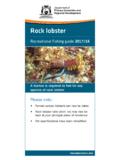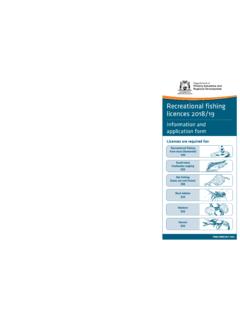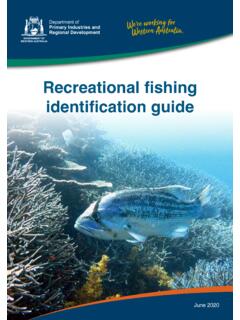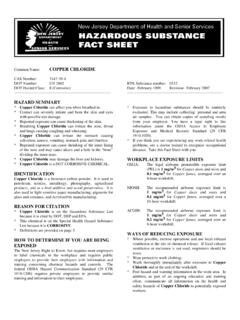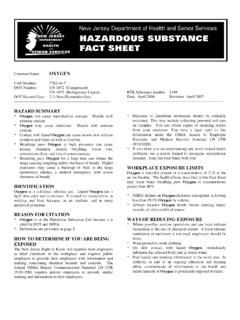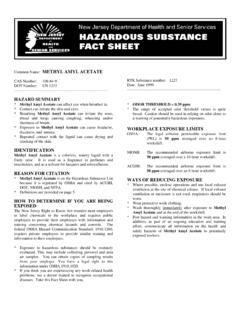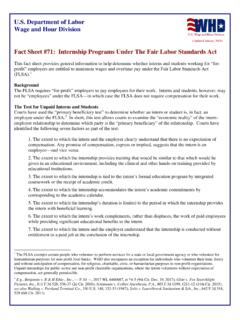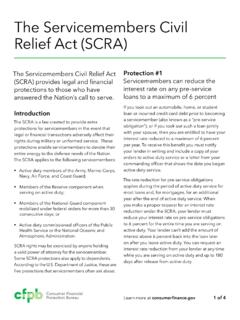Transcription of Fisheries fact sheet - Mud crab - fish.wa.gov.au
1 Page 1 of 4 The magnificent muddy Mud crabs are prized by recreational fishers for their impressive size and delicious taste. Their powerful claws can be dangerous and mud crabs need to be handled with care. Females are often called jennies and males, bucks . In Western Australia there are two species of mud crabs are found in Western Australia s north-west from Shark Bay to the Northern Territory mud crab species Scylla serrata can grow up to 300 millimetres in shell width and kilograms.
2 The species Scylla olivacea can grow up to 150 millimetres in shell width and for their big claws, mud crabs belong to a group of crabs that have the last pair of legs flattened for swimming. They have a smooth carapace (outer shell).The fisheryThe commercial mud crab fishery is only small in Western Australia, producing up to five tonnes annually. However, mud crabs are popular with recreational fishers. For bag and size limits visit its shell A crab s growth isn t continuous, but results from a series of moults that happen when it reaches the size of its current shell.
3 Moulting is triggered by hormones. A new cuticle (hard protective layer) is secreted under the old shell. The crab rapidly absorbs water, splitting its shell along suture lines, then backs out of the old shell. Substances stored within the crab s body are rapidly redeposited to harden the new cuticle into a larger shell. The fluid in the body is replaced with meat during a period when the crab feeds width of a mud crab s carapace can reach 100 millimetres in about a of mud crabs in Western AustraliaPerthMud CrabPubLISHEd MarCH 2013 Fisheries fact sheet Green mud crab Scylla serrata Brown mud crab Scylla olivaceaPage 2 of 4 Where they live Mud crabs prefer sheltered waters such as estuaries and mangrove areas.
4 They are highly tolerant of variations in water salinity and temperature. Although many occupy burrows in the intertidal zone (where the land is exposed at low tide), most adults live in areas that are below the low-tide mark but are still shallow, where they bury themselves in the mud during the day. Catching themCrabs are caught using a baited drop net or by hooking them out of their burrows. Most recreational fishers focus on creeks and rivers although many crabs can be found on coastal flats, usually next to a creek mouth.
5 Brown or green?In total there are four species of mud crab, but only two are found in WA: Scylla serrata (the green mud crab) and Scylla olivacea (the brown mud crab).They don t actually look green and brown, despite their names. The names were originally used to reflect the types of environments they were thought to minimum size you re allowed to keep differs. For this reason, fishers need to be able to tell them apart. Green mud crabs have a larger size limit because they mature at a larger size.
6 If browns were to have the same size limit, they would never be taken as they rarely grow that similar in appearance, there are some key differences: Green mud crab (Scylla serrata) Brown mud crab (Scylla olivacea)Identifying features:1. Elbow : Has more than one prominent sharp Claws: Dark green/purple coloured, claw spines are large and distinct. 3. Lobes : Long, narrow lobes between the features:1. Elbow : Has one small blunt spine or no spines at all. 2. Claws: Light brownish-orange coloured, claw spines have reduced or blunt prominences.
7 3. Lobes : Short, broad lobes between the Leeuwin Current flows south when the current is strong, short-lived populations of mud crabs have been found as far south as Wilson Inlet, near vice-like gripMud crabs can be fast and strong and their big claws can make catching them extremely dangerous. Once locked on, a claw will remain in a vice-like grip even if it s been detached from the animal. Take precautions when handling a mud crab; wear a heavy-duty glove, use tongs or distract the claws with a crabs use their claws to defend themselves and will even shed a claw to escape.
8 In many cases, a new, fully functional claw will grow green mud crab4. Walking legs: Obviously patterned (mottled) Walking legs: May have very faint pattern on 3 of 4 Lifecycle1. Zoea: A mud crab begins life as a larva called a zoea , which hatches from an egg. It is about one millimetre long with undeveloped limbs and looks a little like a tadpole. The zoea floats in the water with plankton microscopic organisms that drift in clusters. 2. Megalopa: A zoea grows by moulting four times during a period of 12 to 15 days.
9 As it moults for the fifth time, it transforms into a megalopa, which has functional claws. After a week or so, it moves inshore and settles on the seabed. After a few days, it moults into a juvenile crab. 3. Juvenile crab: The juvenile crab is a miniature version of the adult, about four millimetres wide. About a month after hatching, when 10 20 millimetres wide, it moves to an estuary and settles in a sheltered area. 4. Young adult: The crab reaches sexual maturity at 18 to 24 months. A green mud crab matures at about 110 millimetres (carapace width) and a brown at about 90 Mating: Mud crabs mate in warmer months.
10 Mature females release a pheromone (chemical attractant) into the water to attract males. Once paired, the successful male climbs on top of the female, clasps her with his hind legs, picks her up and carries her around for up to four days. He releases her when she begins to moult. After she has shed her shell, he turns her upside down to mate. The male deposits a capsule of sperm inside the female s reproductive opening, where it s stored for months until the developing ova (eggs) are ready to be fertilised.



